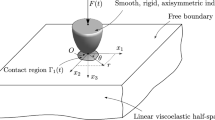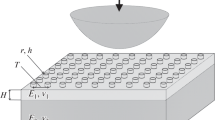Abstract
We investigate indentation by a smooth, rigid indenter of a two-dimensional half-space comprised of periodically arranged linear-elastic layers with different constitutive responses. Identifying the half-space’s material parameters as periodic functions in space, we utilize the theory of periodic homogenization to approximate the layered heterogeneous material by a linear-elastic, homogeneous, but anisotropic medium. This approximation becomes exact as the layer thickness becomes infinitesimal. In this way, we reduce the original problem to the indentation of an anisotropic, homogeneous, linear-elastic half-space by a smooth, rigid indenter. The latter is solved analytically by formulating and resolving the corresponding matrix Riemann–Hilbert boundary-value problem in complex analysis. Thus, we obtain an approximate, but analytical solution for the indentation of a layered heterogeneous medium. We then compare this solution with finite element computations of the indentation on the original layered, heterogenous half-space. We conclude that (a) the contact pressure on the layered, heterogenous half-space is well approximated by that obtained through homogenization, and the approximation improves as the layer thickness is decreased, or if the indentation force is increased; (b) the upper bound of the difference between the two contact pressures depends only upon the ratio of the Young’s moduli of the two materials constituting the heterogenous medium and their Poisson’s ratio; and (c) the average variation of the discontinuous von Mises stress in the layered half-space is well approximated by the one found in the homogenized half-space. The approach presented here can be utilized for a diverse array of indentation and contact problems of finely mixed heterogeneous media, and is also amenable to systematic improvements.









Similar content being viewed by others
Notes
Given two sets \(A\) and \(B\), the set \(A\setminus B:=\{x\in A\mid x\notin B\}\) is the relative complement of \(B\) in \(A\).
References
Doerner, M.F., Nix, W.D.: A method for interpreting the data from depth-sensing indentation instruments. J. Mater. Res. 1(4), 601–609 (1986)
Oliver, W.C., Pharr, G.M.: An improved technique for determining hardness and elastic modulus using load and displacement sensing indentation experiments. J. Mater. Res. 7(6), 1564–1583 (1992)
Muskhelishvili, N.I., Radok, J.R.M.: Singular Integral Equations: Boundary Problems of Function Theory and Their Application to Mathematical Physics. Dover, New York (2008)
Sneddon, I.N.: Fourier Transforms. Dover, New York (1995)
Green, A.E., Zerna, W.: Theoretical Elasticity. Oxford (Clarendon) Press, Oxford (1954)
Fan, H., Keer, L.: Two-dimensional contact on an anisotropic elastic half-space. J. Appl. Mech. 61(2), 250–255 (1994)
Stroh, A.: Dislocations and cracks in anisotropic elasticity. Philos. Mag. 3(30), 625–646 (1958)
Chen, W.F., Han, D.J.: Plasticity for Structural Engineers. (2007). J. Ross Publishing
Ting, T.C.T.: Anisotropic Elasticity: Theory and Applications. No. 45. (1996). Oxford University Press on Demand
Gakhov, F.D.: Boundary Value Problems. Pergamon Press Ltd., Elmsford (1986)
Ingebrigtsen, K., Tonning, A.: Elastic surface waves in crystals. Phys. Rev. 184(3), 942–951 (1969)
Cioranescu, D., Donato, P.: An Introduction to Homogenization. Oxford University Press, London (1999)
Ganesh, S.S., Vanninathan, M.: Bloch wave homogenization of linear elasticity system. ESAIM Control Optim. Calc. Var. 11(4), 542–573 (2005)
Hibbitt, H., Karlsson, B., Sorensen, P.: Abaqus Analysis User’s Manual Version 2016. Dassault Systèmes Simulia Corp., Providence (2016)
Bridgman, P.W.: Dimensional Analysis. Yale University Press, New Haven (1922)
Sadd, M.H.: Elasticity: Theory, Applications, and Numerics. Academic Press, San Diego (2009)
Abramowitz, M., Stegun, I.A.: Handbook of Mathematical Functions with Formulas, Graphs, and Mathematical Tables. Dover, New York (1965)
Jones, R.M.: Mechanics of Composite Materials. 2E. Taylor & Francis, Philadelphia (1999)
Muskhelishvili, N.I., Radok, J.R.M.: Some Basic Problems of the Mathematical Theory of Elasticity. Springer, Berlin (2013)
Acknowledgements
T. M. acknowledges the support from Indo-French Centre for Applied Mathematics (IFCAM) and DST-MATRICS Project no. MTR/2017/000587.
Author information
Authors and Affiliations
Corresponding author
Additional information
Publisher’s Note
Springer Nature remains neutral with regard to jurisdictional claims in published maps and institutional affiliations.
Appendices
Appendix A: Evaluation of \(\mathbf{M}\) for Isotropic Materials
For cases when \(\mathbf{S_{2}}^{-1}\mathbf{S_{1}}\) is not diagonalizable, which happens only if \(\varLambda _{1}=\varLambda _{2}=\varLambda \), we can still find a nonsingular matrix \(\hat{\mathbf{E}}\), such that
where the square matrix on the right is the Jordan normal form of \(\mathbf{S_{2}}^{-1}\mathbf{S_{1}}\). We can then extend the definition of \(\mathbf{M}\) to such cases by writing \(\hat{\mathbf{E}}\) in terms of two \(2\times 2\) nonsingular matrices \(\mathbf{A}\) and \(\mathbf{B}\), as done in (25). We let and define \(\mathbf{M}=i\mathbf{A}\mathbf{B}^{-1}\) as done in Sect. 3.
For an isotropic material with Lamé’s parameters \(\lambda \) and \(\mu \), we find matrices \(\mathbf{Q}\), \(\mathbf{R}\) and \(\mathbf{W}\) using (10) and (19) to be
While diagonalizing \(\mathbf{S_{2}}^{-1}\mathbf{S_{1}}\) with (75), we find \(\varLambda _{1}=\varLambda _{2}=i\), corresponding to which we obtain only one independent eigenvector. Therefore, the matrix \(\mathbf{S_{2}}^{-1}\mathbf{S_{1}}\) for an isotropic material, obtained using (75) is not diagonalizable. Hence, we use its Jordan normal form (74) to compute \(\hat{\mathbf{E}}\), so that
We now easily find \(\mathbf{A}\), \(\mathbf{B}\) and \(\mathbf{M}\), as done in (25) to obtain
In particular, we obtain from (77) that \(M_{22}={(\chi +1)}/{4\mu }\), where we recall that \(\chi ={(\lambda +3\mu )}/{(\lambda +\mu )}\). Thus, for an isotropic material, (41) reduces to (11), as it should.
We, however, cannot use the matrix \(\mathbf{B}\) thus obtained in (44) when \(\mathbf{S_{2}}^{-1}\mathbf{S_{1}}\) is not diagonalizable, because in such a case the general solutions (24), which crucially depend upon this diagonalization, no longer hold and need modification. Therefore, for indentation of an isotropic material, we require a different approach. We follow the results obtained by Muskhelishvili [19], which we compiled at the end of Sect. 2. Muskhelishvili employed a similar complex variables based approach as given in Sect. 3, but employing the structure of an isotropic material right from the beginning, thereby bypassing the problem of lack of diagonalization of \(\mathbf{S_{2}}^{-1}\mathbf{S_{1}}\).
Appendix B: Solutions of the Auxiliary Periodic Problem
We solve auxiliary problem (49) for \(\boldsymbol{\chi }^{lm}\), which are then used in (48) to find the components of the effective stiffness tensor of the homogenized material. For \(l=1\), \(m=1\) and \(i=1\), the PDE
in (49) transforms to
The remaining terms in the above expansion are zero either on account of \(a_{{ijkh}}\)’s being zero for appropriate indices, as is clear from (10), or because \(a_{{ijkh}}(\mathbf{x})=a_{{ijkh}}(x_{2})\), which implies \(\dfrac{\partial a_{{ijkh}}}{\partial x_{m}}=0\) for \(m=1,3\). Using (10), we obtain
Similarly, for \(l=1\), \(m=1\), \(i=2\) and \(l=1\), \(m=1\), \(i=3\), we have
and
respectively. We solve (78)–(80) for \(\boldsymbol{\chi }^{11}(\mathbf{x}):=(\chi ^{11}_{1},\chi ^{11}_{2}, \chi ^{11}_{3})\). To this end, we guess that \(\chi ^{11}_{1}\), \(\chi ^{11}_{2}\) and \(\chi ^{11}_{3}\) are independent of \(x_{1}\) and \(x_{3}\), so that (78), (79) and (80) reduce, respectively, to the following:
Solving the above set of equations, we obtain
Similarly, with the assumption that \(\boldsymbol{\chi }^{lm}(\mathbf{x})=\boldsymbol{\chi }^{lm}(x_{2})\) we solve for other \(\boldsymbol{\chi }^{lm}\) as given below:
We note that \(\boldsymbol{\chi }^{lm}=\boldsymbol{\chi }^{ml}\).
Appendix C: Components of the Effective Stiffness Tensor
Using (48), we compute the components of the effective stiffness tensor of the homogenized material. We start with \(a_{1111}^{0}\):
In the second integrand on the right side above several terms vanish identically because, \(a_{1112}=a_{1113}=a_{1121}=a_{1123}=a_{1131}=a_{1132}=0\) from (10). Also \(\dfrac{\partial \chi _{1}^{11}}{\partial x_{1}}= \dfrac{\partial \chi _{3}^{11}}{\partial x_{3}}=0\) from (81). Thus, we compute
Next, we calculate \(a_{1112}^{0}\):
utilizing (10), along with \(\dfrac{\partial \chi _{1}^{12}}{\partial x_{1}}=0\) and \(\chi _{2}^{12}=\chi _{3}^{12}=0\) from (82). Similarly, we find the other coefficients that are provided in (50).
Rights and permissions
About this article
Cite this article
Sachan, D., Sharma, I. & Muthukumar, T. Indentation of a Periodically Layered, Planar, Elastic Half-Space. J Elast 141, 1–30 (2020). https://doi.org/10.1007/s10659-020-09772-x
Received:
Published:
Issue Date:
DOI: https://doi.org/10.1007/s10659-020-09772-x




